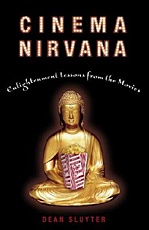"Tibetan temples smell like popcorn. Actually, they smell like the hot buttery goop that's pumped onto popcorn in the lobbies of movie theaters: as I walk from my car on a clear spring New Jersey evening, past the bank and the vacuum cleaner store, I can smell it a block away. What I smelled in Tibet were butter lamps, simple cups of yak butter with lighted wicks, carried by wide-eyed peasants as they walked in silence from one shrine room to the next, or glowing where the resident monks had set them at the feet of gold-painted buddhas. Like movie theaters, the temples are windowless and dark. The butter lamps, burning there for centuries, have coated everything with a fine layer of sooty grease, so that the stone floors, like the floors of movie theatres, are sticky underfoot.
"The earliest of these temples were erected in the eighth century, when Padmasambhava and a few other illustrious teachers carried the dharma — the enlightenment teachings of the Buddha — from India. In Tibet, they found a preliterate society incapable of reading the texts they had brought. Fortunately, they had also brought the lavish system of visual symbolism we still see in the remaining temples, where every detail of the paintings and statues, down to the weapons wielded by a wrathful deity or the color of a lama's undershirt, conveys some part of the teaching.
"In today's postliterate society, where people can read books but spend most of their time gazing at various kinds of glowing screens instead, perhaps we can find enlightenment lessons in the movies. Perhaps, if we look close enough, there are dharma teachings in the weapons wielded by Clint Eastwood or the color of Grumpy's eyes. God, they say, is in the details.
"Maybe, if we take that saying literally, we can find the infinite looming in the way Sonny Corleone dies at the tollbooth or in the shark's -eye-view shot that opens Jaws. Of course, Disney, Leone, Coppola, and Spielberg are no Padmasambhavas, but like all great artists, in their most inspired moments they touch places beyond their own understanding. Plato imagined people sitting before a fire in a dark cave, watching flickering shadow shows that hint at the higher reality of the sunlit world and that eventually prompt them to emerge into the light. Perhaps our flickering movie shows can help point us to a higher, more light-filled reality, if only we can decipher the hints.
"In a way, I've been trying to decipher them since I was six, when my parents took me to see Forbidden Planet. Robby the Robot, Dr. Morbius with his dark secrets and his beautiful daughter, the invisible Id monster stomping giant footprints in the dust of Altair-4, the spooky, quavering electronic music — Woo-OOO-ooo! — all this suggested a mysterious, alluring cosmic dimension. I didn't know where it was or what it had to do with me, but it was out there and I wanted it. I embarked upon a lifelong love affair with movies, eventually spending several years working as a film critic. Meanwhile, my pursuit of the cosmic led me to study with lamas and yogis, attend retreats in the U.S. and Europe, and trek to cave shrines and butter lamp-filled temples in Tibet and Nepal. Maybe it was inevitable that someday these two passions would once again converge."
